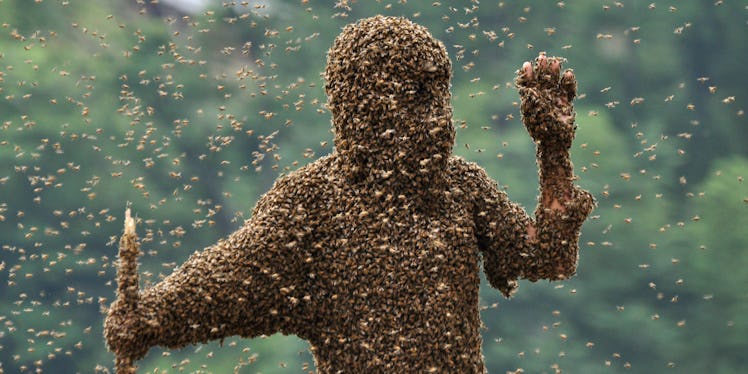Everything Your Kid Needs To Know To Avoid Bee Stings
To bee or not to bee?

Kid vs. Wild will help you teach your kid how avoid stings, bites, scratches, and the occasional mauling from animals that are more dangerous than other children.
Statistics says the chance of getting stung by a bee is about 6 million-to-one, but do you honestly know anyone that hasn’t been stung before? It’s kind of a right of passage for most kids — unless your kid is as allergic to stings as Macaulay Culkin in My Girl.
If that’s the case you’re probably already carrying an Epi-Pen and a boatload of anxiety when you’re at a picnic. But, because you can’t always be there to swat away the swarms, arm them with information on how to not get stung in the first place. First lesson: You can get honey in a grocery store, now.
Look For Hives
Arm them with the power of observation. Check under surfaces and inside play areas. If they do find a hive, tell them to stay calm and slowly walk away from the area. Remember, according to that kid in Jerry Maguire, bees and dogs can smell fear.
Bees Vs. Wasps
Your average honeybee or bumblebee just wants to buzz around and make sweet, sweet honey. If they think you’re a flower (clearly you’re not) they may dive bomb you a few times to investigate, but they’re not there to linger about.
Wasps — which include the smaller, bee-like Yellowjackets — are more of an issue because they can be more aggressive and enjoy human food like cupcakes, watermelon, and soda. You know, all the crap you eat at a BBQ. Not to get you paranoid, but you also want to also check open cans and cups before drinking.
Stop Pretending To Be A Flower
All of these insects are attracted to one thing more than anything else: Scents. That means no perfume, cologne, or lavender-scented baby lotions. And bees are attracted to bright colors and floral patterns, so tone it down outside. (That’s also just a general fashion tip.)
Don’t Call In The SWAT Team
Swatting at bees will only make things worse. That flailing triggers an alarm, which triggers its defensive posture, which triggers other bees. When a bee stings, it releases a chemical that attracts its brothers like a Viking battle cry. A very buzzy cry.
What To Do If You’re Being Swarmed
Run. That’s it. It’s the only tried and true method to escape a swarm of bees. Get away and get to shelter. If there’s no shelter to be found, keep on trucking and try and find some tall grass or bushes to run through to divert the attack. Some swarms have been known to follow their victims up to a half a mile or further before giving up their pursuit.
Avoid The Water
Don’t jump in the nearest body of water. Unfortunately, bees are pretty smart and it’s been well documented that they’ll just wait until you come up for air to sting, even targeting a person’s nose.
How To Remove A Stinger
In the event somebody gets stung, quickly remove the stinger. Once it’s stuck in their skin, the attached sac can still pump out venom up to a minute after. Drag a fingernail or the edge of a credit card to remove it — but don’t use tweezers, or else you risk squeezing more venom.
You’re Having A Swell Time
Even if kids aren’t allergic to bee stings, you may notice swelling. Even a lot of swelling is normal … and not a fun time. Use Benadryl first and ice second. If areas that weren’t stung start ballooning — especially near the neck — it’s time to go to the hospital. Your vendetta against the hive will have to wait.
This article was originally published on